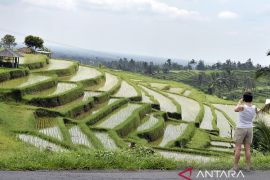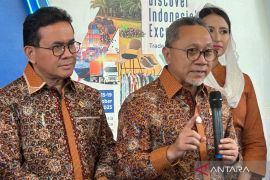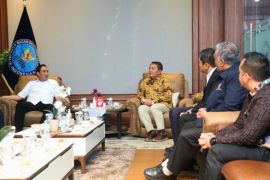In the near future, we will install the water pump with SHS technology at three locations, namely Karangrena Village (Maos Sub-district), Karangsari Village (Adipala Sub-district), and Kutawaru Village (Central Cilacap sub-district).Cilacap, C Java (ANTARA) - Priyatno was engrossed in checking the condition of the groundwater pump in the rice farming area in Kalijaran Village, Maos Sub-district, Cilacap District, Central Java, which was located in proximity to the Surabaya-Bandung railway track.
As Head of Kalijaran Village’s Margo Sugih Farmers Group Association (Gapoktan), Priyatno is tasked with managing a solar-powered groundwater pumping station using the Solar Home System (SHS) technology designed by a team from Cilacap State Polytechnic (PNC).
Priyatno is pleased with the application of the SHS technology since it can help farmers in the village to meet the water requirements for their rainfed rice fields.
In fact, the water pumping facility is also used by several farmers from the neighboring villages, as their fields are also close to the pumphouse.
Rice fields in the southern region of Kalijaran Village and its surrounding areas are not equipped with a technical irrigation network.
Related news: President Jokowi inaugurates Pidekso Dam in Central Java
In addition, the only small river flowing near the agricultural area cannot be used optimally to irrigate fields during the dry season owing to frequent sea water intrusion into the stream.
Before the SHS technology was implemented, local farmers used the oil-fueled pump to channel water from the river to irrigate their fields.
With the solar-powered pump being operated, farmers can cut their operational costs since they do not need to spend their money to buy the fuel and rent the oil-fueled pump that costs Rp20,000 (US$1.34) per hour.
Related news: President Jokowi inaugurates Karalloe Dam in Gowa, South Sulawesi
Solar pump
Priyatno recalled having spent Rp500 thousand (US$33.62) during a planting period to irrigate his rice field spanning two thousand square meters.
However, since the solar-powered water pump station began operating, he no longer has to pay for the oil-fueled pump charge.
In addition, farmers do not have to harbor concerns regarding various requirements when they purchase the subsidized fuel.
"If we buy Pertamax (one of the non-subsidized fuels), we can (simply) use the jerry cans, though the price is higher," the head of Margo Sugih Gapoktan noted.
Meanwhile, the maintenance costs of the solar-powered pump have been covered by Gapoktan’s budget, so members of the farmer group do not need to spend money to utilize the pump.
Furthermore, farmers from neighboring villages can use the pump without any charge, though sometimes, they still give donation to Gapoktan as a good-will gesture.
Priyatno has planned to optimize the solar-powered water pump station in order to develop the horticulture sector during the dry season, so that the economy of local farmers will not solely rely on rice cultivation.
Related news: Citarum water is safe for fish cultivation, irrigation: governor
SHS Technology
The development of SHS technology was initiated by PNC academic, Afrizal Abdi Musyafiq.
He said the idea to develop the technology was encouraged by the fact that farmers in Kalijaran Village still used oil-fueled pump to meet the water demands for their rainfed rice fields.
In fact, on average, seven liters per day of fuel is required to operate the machine for a rice field, with an area spanning about 2,100 square meters.
Meanwhile, the area needs to be watered around eight times during a plantation period.
Hence, to solve the issue, his side channels the water from a drilled well, with a depth of about 20-30 meters, by using a solar-powered electric water pump.
Thus, the water pump station is energy independent since it does not depend on a conventional electricity grid.
Furthermore, Musyafiq, who teaches the Renewable Energy and Power Generation System course at PNC, noted that the station can produce 20 thousand liters per day of water.
In addition, the capacity of the installed solar panels is 500 watts, while the machine is able to operate 12 hours a day.
The water pumphouse is also equipped with a battery to store the energy generated by solar panels during the day. Thus, the pump can also be operated at night by using the energy from the battery.
The SHS technology can last up to a decade according to the average battery and solar panel life.
Meanwhile, investment to develop the solar-powered water pump station is only about Rp80 million (US$5.3 thousand).
"In the near future, we will install the water pump with SHS technology at three locations, namely Karangrena Village (Maos Sub-district), Karangsari Village (Adipala Sub-district), and Kutawaru Village (Central Cilacap sub-district)," Musyafiq noted.
Related news: President Widodo inaugurates Way Sekampung Dam
Award-winning technology
The SHS technology bagged an award in the new and renewable energy-based technology innovation competition held by the state-run oil and gas company PT Pertamina’s institution for corporate social responsibility (CSR), Pertamina Foundation (PF).
The foundation held the 2022 PFScience Program to laud energy practitioners for their consistence in developing and creating various clean energy-based innovations that are affordable for the community.
Hence, the establishment of a solar-powered groundwater pump in Kalijaran Village showcases the recognition of the foundation to the works of the PNC team.
Area Manager for Communication Relations and CSR of PT Kilang Pertamina Internasional (KPI) Refinery Unit (RU) IV Cilacap -- one of PT Pertamina’s subsidiary -- Cecep Supriyatna noted that the pump was established through collaboration of the Pertamina Foundation, PT KPI RU IV Cilacap, and PNC to help farmers in Kalijaran Village.
The SHS technology can also become an alternative solution in helping to fulfil the water needs for rainfed rice fields and communities in areas not having conventional electricity networks.
In addition, SHS technology is environmentally friendly, as there is no risk of pollution due to leaked fuel or lubricating oil from the pump’s engine.
Hence, the technology should be adopted in all regions across Indonesia, especially for farmers with limited cultivation areas or inadequate water irrigation system.
Related news: High level of rice stock proves RI's food system resilience: Jokowi
Related news: Jakarta Governor visits Japan to discuss cooperation in transportation
Editor: Fardah Assegaf
Copyright © ANTARA 2022












